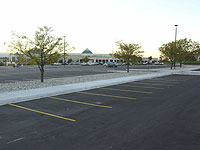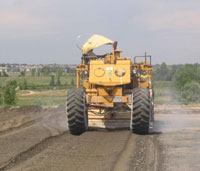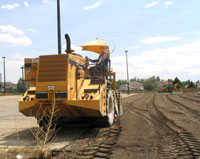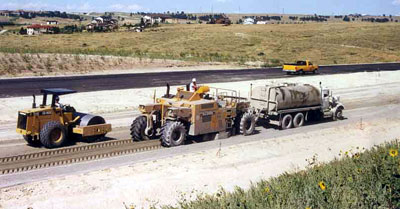By Jeff Hawk

When estimators for subcontractor ARS, Inc. bid the Front Range Community College parking lot reconstruction project in Westminster, Colorado, they figured 8 percent Type C flyash would meet the specified 160 pounds per square inch (psi) strength requirement. The 30,000 square yard project called for pulverizing and stabilizing the parking lot’s existing 4-inch asphalt surface and clay/sandy clay subgrade 12 inches deep, and then resurfacing with four inches of new asphalt.
DeFalco Lee Construction topped the cement-recycled base with four inches of asphalt.
Designers considered stabilizing the subgrade with lime but chose flyash because of a short construction deadline. Lime requires a mellowing and remixing process where cement or flyash can be processed in the same day it is applied. “We fast-tracked it because we had to get it done before the students came back to school,” said Skip DeFalco, president, DeFalco Lee Construction, Longmont, Colorado.
Unfortunately, geotechnical testing of the site’s soil provided by DeFalco showed that an 8 percent flyash mix came up far short of the 5-day strength requirement.
Test results indicated it would take a 15 percent flyash mix design to meet the 160 psi strength requirement, nearly doubling the estimated amount of stabilizer and severely cutting into ARS’ profit margin. “It went from being a good job to a major money loser,” said ARS co-owner Kim Haarberg.
The Littleton, Colorado-based company decided to run a new mix analysis comparing cement to flyash. Geotechnical firm Kumar & Assoc., Inc., Denver, Colorado, tested the two materials using a 5-day, 100-degree Fahrenheit moist cure criteria for determining strength. Cement supplier Holcim Inc. provided cement for the test.
Results showed that a much lower volume of cement produced a significantly stronger product, according to Jim Noll, a senior engineer for Kumar & Associates. The tests revealed that a 14 percent mix of Type C flyash yielded 214 psi while a 3 percent cement mix produced 295 psi. In other words, five times less cement produced a much stronger unconfined compressive strength. “We ran a lot of flyash and didn’t get the strength,” said Noll. But the 3 percent cement mix produced a “really good product” that was “pretty darn hard,” he said. “It’s a better product when you’re dealing with stabilizing a pulverized layer.”

 DeFalco and Front Range officials allowed the change order to cement. The switch produced numerous benefits. ARS crews worked with much less stabilizer, which sped construction and reduced truck traffic on the college campus. “Minimizing the impact to students was a big issue,” said Noll.
DeFalco and Front Range officials allowed the change order to cement. The switch produced numerous benefits. ARS crews worked with much less stabilizer, which sped construction and reduced truck traffic on the college campus. “Minimizing the impact to students was a big issue,” said Noll.
Using Cement allowed DeFalco Lee Construction and its subcontractors and its subcontractor ARS Inc. to finish the parking lot before students returrned to classes.
Trucks hauled in 500 tons of cement for a project that would have required nearly 2,500 tons of flyash. “And trucks are in scarce supply,” added Haarberg. Recycling the existing asphalt with cement further reduced traffic and saved money. “Why haul off good material?” said Noll.
The thinner application and higher density of cement compared to flyash required less water addition and also produced less dust during construction, said Haarberg. And cement is a “very consistent product,” he added. “It’s a product, not a by-product.”
In August, torrential downpours threatened to put the project behind schedule. But the cement-treated subgrades held up under the pouring rains. “We were able to get back on it immediately,” said DeFalco.
The most significant benefits were the cost-savings and the stable platform that cement provided for DeFalco pavers. “Not only did cement pull our butts out of the fire, but DLC’s DeFalco said it’s one of the best subgrades he’s ever worked on,” said Haarberg.

Pulverization of the existing materials is usually achieved with one or two passes.

Pulverizing the existing asphalt and base save time , money. and natural resources.

Recycling the existing asphalt and base is seeing use on major
highways as well as city streets and parking lots.
For more information, visit the Cement Council of Texas at www.RecyclingRoads.org.